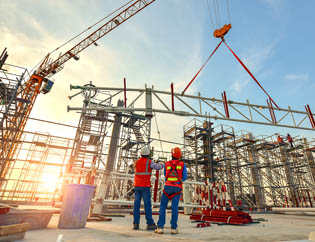What Are Construction Cost Codes

What are Construction Cost Codes?
Codes in construction help standardize the documentation process. But overly complex cost coding processes can work against you.
The market for commercial construction in the United States is a little more than $230 billion in 2022, according to research firm IBISWorld. Given the high monetary stakes and the complexities at various stages of the project, construction companies need to rely on standardized processes to keep an eye on costs.
Budget and construction cost management codes are efficient ways to do so. They enable firms to categorize costs, understand spending patterns, and easily provide the documentation necessary for governmental reporting and oversight.
Developing Construction Cost Codes
 The total cost of a construction project can be broken down into a list of line items, each of which includes:
The total cost of a construction project can be broken down into a list of line items, each of which includes:
- Construction phase
- Construction codes
- Construction types
Construction phase: The construction phase is essentially the building process and any related activities such as demolition, site preparation, or refurbishment. While the general contractor will oversee a construction project, it is common to divide the project into construction phases, such as design, warranty, tenant improvements, etc.
Construction codes: The number included in the construction code indicates which aspect of the project is being addressed. Giving each line item in the project a distinct and standardized code helps construction professionals easily understand the language. Most companies in the United States follow the cost code protocols established by the Construction Specifications Institute. For example, if a line item lists 03, it means concrete, while 08 means doors and windows. The CSI specifies 48 such codes.
Construction types: These are the categories within a cost code. For example, even under concrete, you might have the following different cost types (to name a few):
- Labor
- Equipment
- Materials
The Benefits of Using Construction Cost Codes
While there are many benefits to using cost codes, the most notable include standardization, cost control, real-time tracking and profitability.
- Standardization – Standardization of cost codes is immensely useful as it leaves no room for misinterpretation of project information or costly delays caused by data errors.
- Cost control – By adopting standardized cost codes, organizations can track costs more efficiently and manage project budgets with a sustainable process.
- Real-time tracking – When cost codes are used by your construction management software, project data can be easily maintained, accessed and reported on with accurate, real-time tracking.
- Profitability – Cost code data related to construction types (i.e. equipment, labor and material) can be used to identify areas where a project is going over budget or where profit is more quickly realized.
Professionals also might not always appreciate being locked into a rigid WBS system.
Construction Cost Codes in WBS and Flat Organizational Structure
 Keeping this method of classifying projects as context, construction firms use techniques that broadly shake out into two categories:
Keeping this method of classifying projects as context, construction firms use techniques that broadly shake out into two categories:
- Work breakdown structure (WBS)
- Open or flat structure.
WBS is a project management system not unique to construction, which breaks down categories into detailed hierarchies. Such a level of detail allows managers to pinpoint, to exacting detail, where the money is being budgeted and spent–and when. This mirrors the same structure you would use in scheduling a project only with a focus on the financial aspect of things.
The open structure allows more flexibility if managers are unsure of hierarchies and want to build the code without being tied to a fixed set of parameters even before they have a clear understanding of the project. You can elect to utilize the same breakdown as a WBS structure, simplify your options, or do a combination of the two.
In addition to construction cost code and cost types, industry professionals can break down projects into even more detail using “segments” as needed. So a complete code would look like: Project phase–Construction Code–Construction Type–Segment
While it might be tempting to set-up 10 levels of complexity to really nail down a code, such detail can easily become overwhelming and difficult to document consistently.
Looking Beyond Cost Codes in Construction Management Software
 While construction management software companies sometimes brag about the level of segments their programs are capable of accommodating, it helps to remember that such complexity can be overkill and unnecessarily overwhelming for documentation purposes. Professionals also might not always appreciate being locked into a rigid WBS system. Keeping an eye on the big picture will give you more clarity about the key factors to evaluate when picking a construction management software program.
While construction management software companies sometimes brag about the level of segments their programs are capable of accommodating, it helps to remember that such complexity can be overkill and unnecessarily overwhelming for documentation purposes. Professionals also might not always appreciate being locked into a rigid WBS system. Keeping an eye on the big picture will give you more clarity about the key factors to evaluate when picking a construction management software program.
Here is what to keep in mind:
End Users & End Use Cases
If one subcontractor is assigned all the work, it might be easier to break down the project by subcontractors rather than drilling down to windows and labor and more. Determine the level of granularity by figuring out the amount of tracking you need done and, equally important, who needs to work with the documents. While it might be tempting to set-up 10 levels of complexity to really nail down a code, such detail can easily become overwhelming and difficult to document consistently. Such constraints might lead to workers skipping documentation altogether or increasing errors.
Flexibility
Pick a program that delivers flexibility in its budget code structure so you can make your reporting as simple or as complex as you need it to be. Groups that are not dependent on each other give additional flexibility when it comes to higher-level tracking. Check that the software program gives you that level of flexibility and does not force you into a rigid tiered process before you’re ready.
No Lock-in
Some software packages might promise lots of granularity but insist you arrange components in very specific ways. Be wary of systems that insist on a set protocol. You do not know what technologies are coming down the pike and how your tech stack will want to talk to various components in the future.
Ease of Integration
Enterprise resource planning systems track budget items with a historical view. Project management software is adept at change management and understanding how changes down the line can impact future forecasts. The ideal project management software will integrate easily with the ERP system of your choice so you save time and effort and improve accuracy, instead of having to key in data into two separate systems. Use of ERP in construction is not going anywhere so look for project management software that integrates easily.

Success in Construction
A successful construction project depends on visibility–into your financials, design and drawings, documentation, change orders. You cannot make room for something you can’t see.
The construction project management software needs to accommodate the way you work right down to the construction codes you need to incorporate. It cannot afford to lose sight of the larger picture though. Flexibility and the ability to work well within your integration ecosystem have been–and always will be–the biggest plus points in a construction management software system.
Trimble ProjectSight has an open structure for creation of construction codes so you are not locked into a rigid hierarchy at the very outset. At the same time, you can dictate the level of recording complexity you want. Equally important, it understands the real-world system in which you operate and integrates with your existing ERP systems and much more.